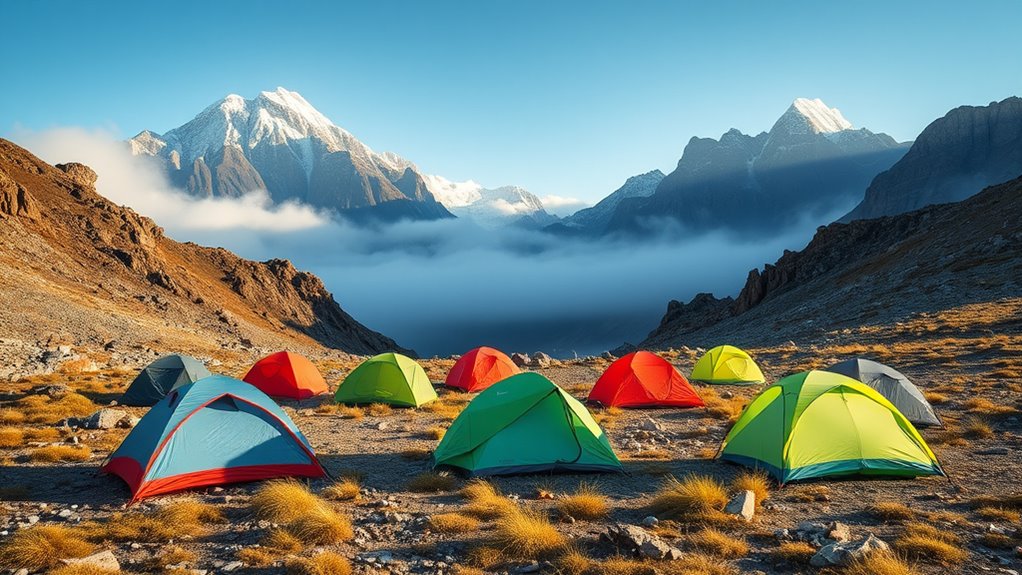If you’re looking for the best ultralight tents for backpacking in 2025, I’ve got you covered. I’ve researched lightweight options like the Big Agnes Copper Spur HV UL, KAZOO Waterproof Tent, and MC TOMOUNT Bivy, which combine durability, weather resistance, and easy setup. These tents are great for solo or duo adventures and pack down small. Want to discover more about top models and features? Keep exploring to find the perfect match for your trips.
Key Takeaways
- Emphasizes lightweight materials like nylon and aluminum to ensure portability without sacrificing durability.
- Features quick and easy setup designs, including color-coded poles and support from trekking poles.
- Offers excellent weather resistance with waterproof fabrics, sealed seams, and stormproof features suitable for various seasons.
- Provides ample ventilation through mesh panels and adjustable vents to reduce condensation and improve comfort.
- Includes compact packing sizes and versatile designs ideal for solo backpackers, hikers, and stealth camping in diverse environments.
Backpacking Tent, Floating Cloud 2, 2-Person Ultralight Waterproof Tent
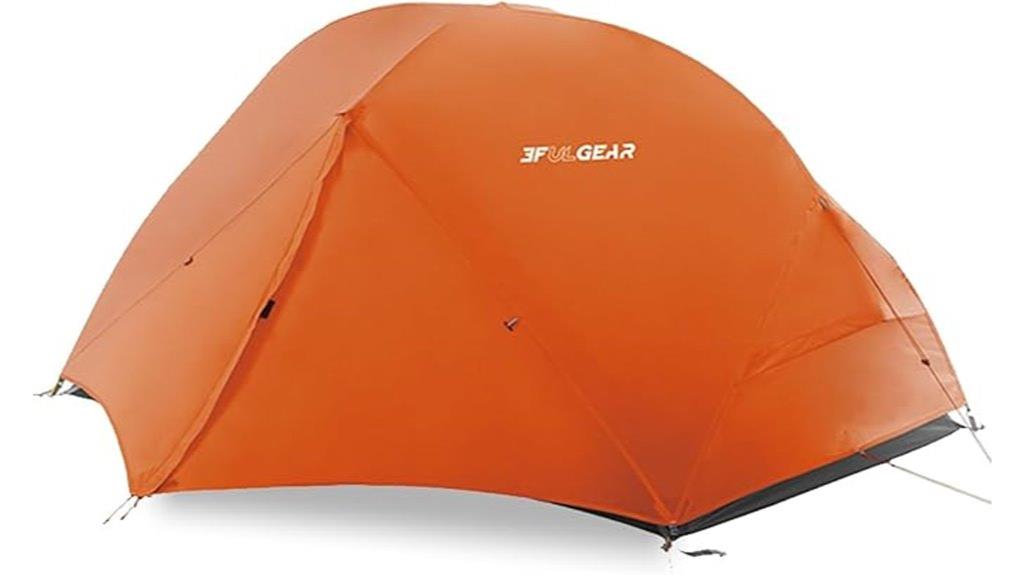
If you’re a backpacker looking for a lightweight, reliable shelter, the Floating Cloud 2 by 3FULGEAR is an excellent choice. This 2-person ultralight tent is designed for all terrains and weather conditions, making it versatile for camping, hiking, or survival situations. It features two doors, spacious vestibules, and excellent airflow with low-vent vestibule doors and side fly vents to reduce condensation. Constructed from durable, waterproof materials with seamless heat-bonded seams, it offers exceptional weather resistance. Weighing just 2.38 kg and packing down small, it’s perfect for backpackers seeking a simple, fast-to-setup tent that doesn’t sacrifice durability.
Best For: Backpackers and outdoor enthusiasts seeking a lightweight, durable, and versatile tent suitable for various weather conditions and terrains.
Pros:
- Ultralight design weighing only 2.38 kg, ideal for backpacking and hiking.
- Double-layer construction with seamless heat-bonded seams for enhanced waterproofing and weather resistance.
- Features two doors, spacious vestibules, and excellent airflow options to reduce condensation and increase comfort.
Cons:
- Designed as a 3/4-season tent, may not be suitable for extreme summer or heavy winter conditions.
- Slightly compact inner dimensions might be tight for two users with gear.
- Limited color options and availability may restrict customization preferences.
Clostnature Polaris Lightweight Camping Tent (Various Sizes)
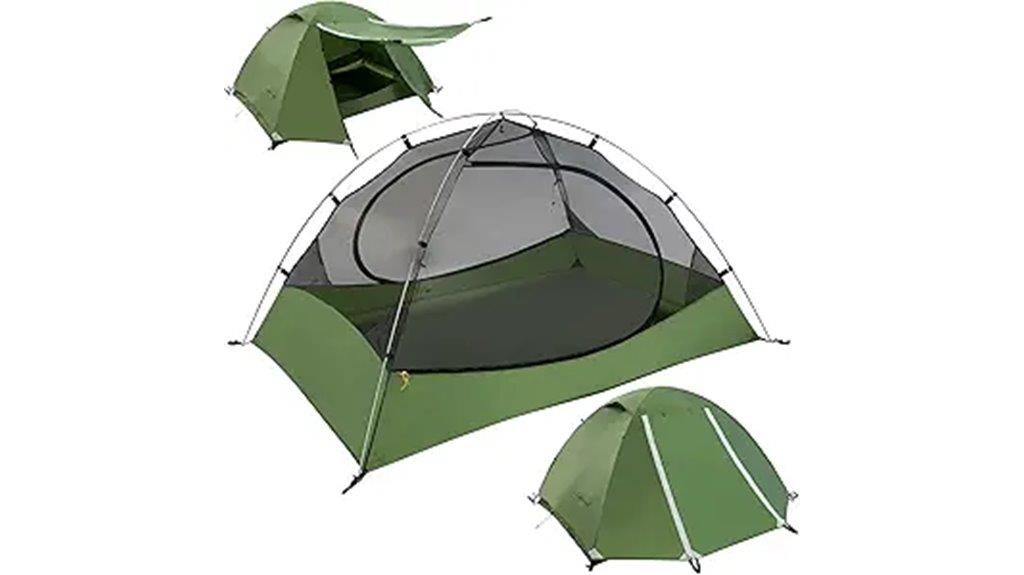
The Clostnature Polaris Lightweight Camping Tent stands out as an ideal choice for backpackers who need a versatile and easy-to-setup shelter without adding extra weight to their pack. It’s a 3-season, ultralight tent available in various sizes for 1 to 6 people. Made of durable polyester with waterproof PU 5000 coating, it keeps you dry in rain and withstands moderate winds. The dome shape, mesh panels, and large doors ensure excellent ventilation. Weighing around 5.3 pounds, it packs down small and is quick to assemble with just two aluminum poles. Its affordability, space, and weather resistance make it perfect for backpacking, camping, and outdoor adventures.
Best For: Backpackers and outdoor enthusiasts seeking a lightweight, easy-to-setup tent suitable for 1-6 people in moderate weather conditions.
Pros:
- Ultralight and compact, easily fitting into small backpacks for convenience and portability.
- Quick and straightforward to assemble, often in under 15 minutes, making it ideal for on-the-go setups.
- Waterproof with durable polyester and sealed seams, providing reliable protection during rain and moderate winds.
Cons:
- Thin aluminum poles may not withstand high winds or gusts exceeding 30-40 mph, limiting durability in extreme weather.
- Small vestibules and limited gear storage space, which may be insufficient for larger gear or multiple users.
- Lacks a groundsheet or footprint included, requiring an additional purchase for ground protection on rough terrain.
Clostnature Crux Lightweight Backpacking Tent (1/2/3/4 Person)
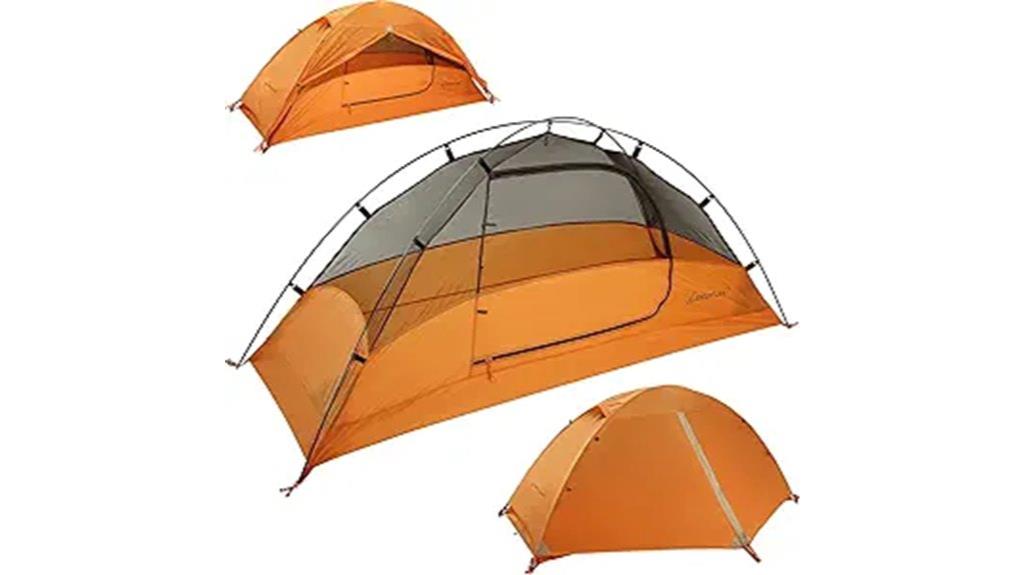
Designed for backpackers who prioritize weight without sacrificing durability, the Clostnature Crux Lightweight Backpacking Tent offers an excellent balance of easy setup, weather resistance, and compactness. Made from durable polyester with sealed seams, it’s waterproof and suitable for all seasons. Its freestanding dome design, reinforced poles, and adjustable guy lines ensure stability in gusty conditions. Weighing just 4 pounds and packing down to 15×5.1 inches, it’s easy to carry and quick to set up solo in about three minutes. Inside, mesh walls provide ventilation, while the large vestibule offers secure gear storage. Overall, it’s a versatile, reliable choice for solo or small group adventures.
Best For: solo backpackers and small groups seeking a lightweight, durable, and weather-resistant tent for all-season outdoor adventures.
Pros:
- Ultralight and compact, easy to carry for backpacking, hiking, and bikepacking trips
- Quick and straightforward setup in around three minutes, suitable for solo deployment
- Waterproof with sealed seams and reinforced structure, ensuring durability in diverse weather conditions
Cons:
- Some users reported quality control issues such as bent stakes or mismatched loops
- Limited interior space for larger gear or taller occupants, may be tight for some users
- Slightly higher price point compared to basic tents with similar features
Clostnature Polaris Lightweight Camping Tent
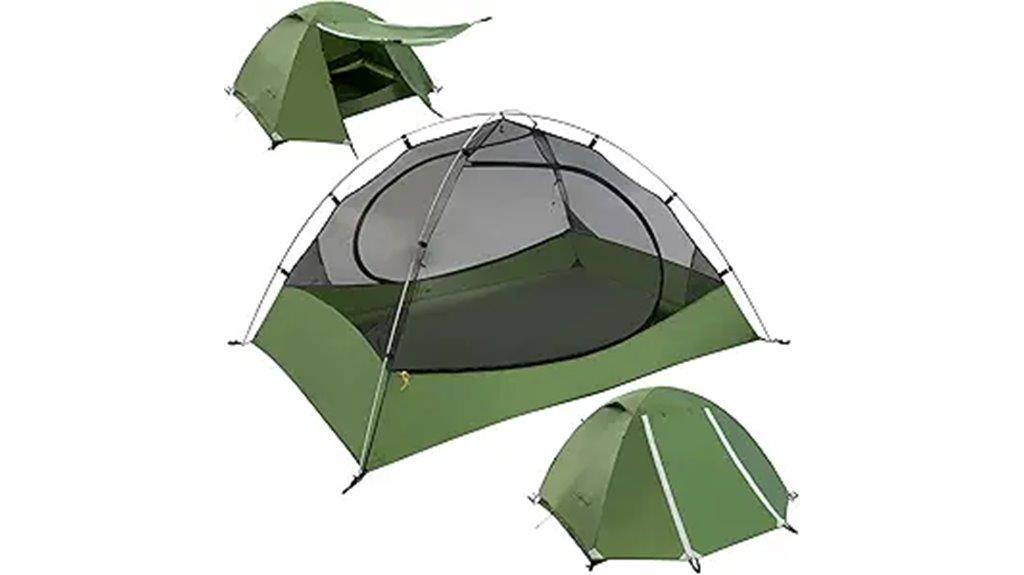
For backpackers prioritizing lightweight gear without sacrificing durability, the Clostnature Polaris Lightweight Camping Tent stands out as an excellent choice. Made from waterproof polyester with a PU 5000 coating, it’s designed to keep you dry in all weather conditions. Its mesh walls promote ventilation, while two D-shaped doors and side vestibules offer easy access and extra storage. Weighing just about 5.29 lbs (2.4 kg), it’s highly portable and quick to set up with aluminum poles. Suitable for 2-4 people, this tent is ideal for moderate conditions, offering reliable waterproofing, ventilation, and convenience for outdoor adventures on a budget.
Best For: backpackers and outdoor enthusiasts seeking a lightweight, easy-to-setup tent with reliable waterproofing and ventilation for moderate weather conditions.
Pros:
- Ultralight and highly portable at approximately 5.29 lbs (2.4 kg)
- Quick and easy setup with freestanding aluminum poles
- Effective waterproof design with sealed seams and weatherproof fly, suitable for all-season use
Cons:
- Thinner material compared to more expensive tents, potentially affecting long-term durability
- Stakes may bend on rocky or uneven terrain, requiring extra caution or reinforcement
- Limited suitability for harsh weather conditions or heavy wind beyond moderate gusts
ALPS Mountaineering Lynx 1-Person Tent
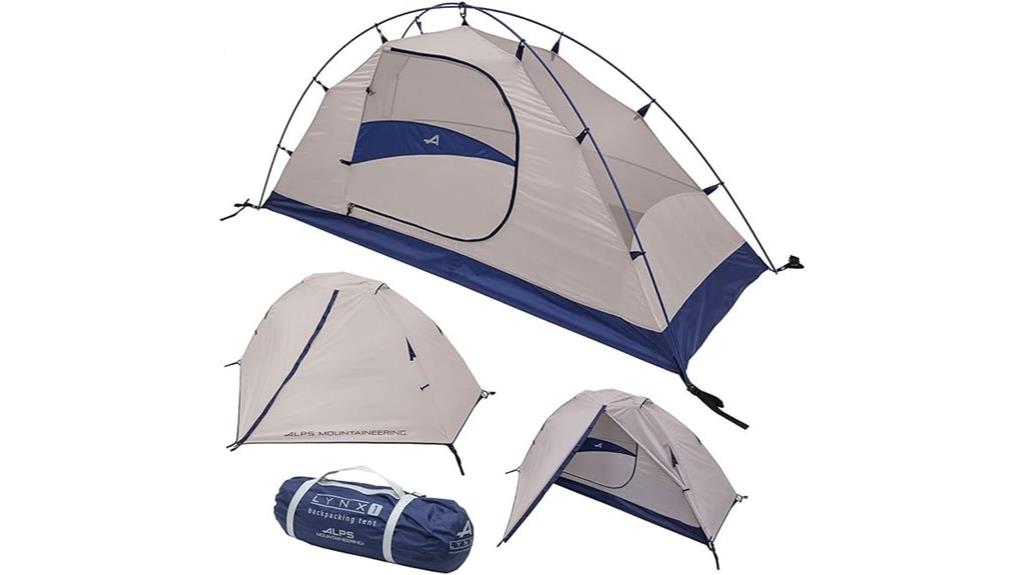
If you’re a solo backpacker seeking a reliable, lightweight shelter, the ALPS Mountaineering Lynx 1-Person Tent is an excellent choice. Weighing just over 4 pounds, it’s quick to set up with clip attachments and features durable aluminum poles. The waterproof rainfly and sealed seams keep you dry in rain, while mesh walls promote ventilation and reduce condensation. Its spacious interior and vestibule provide ample room for gear, making it versatile for three-season adventures. Although some users suggest upgrading stakes, overall, the Lynx offers a sturdy, easy-to-use, and budget-friendly option perfect for backpackers prioritizing weight, durability, and protection.
Best For: solo backpackers seeking a lightweight, reliable, and easy-to-assemble tent for three-season outdoor adventures.
Pros:
- Lightweight and portable at just over 4 pounds, ideal for backpacking.
- Quick and straightforward setup with clip attachments and durable aluminum poles.
- Excellent waterproofing with sealed seams and high-quality rainfly and floor coatings.
Cons:
- Stakes may be flimsy and could benefit from upgrading for extra stability.
- Zippers can sometimes catch on the fly, requiring careful handling.
- Slightly snug for two people, limiting extra space for gear or comfort.
Forceatt 2-3 Person Waterproof and Windproof Camping Tent
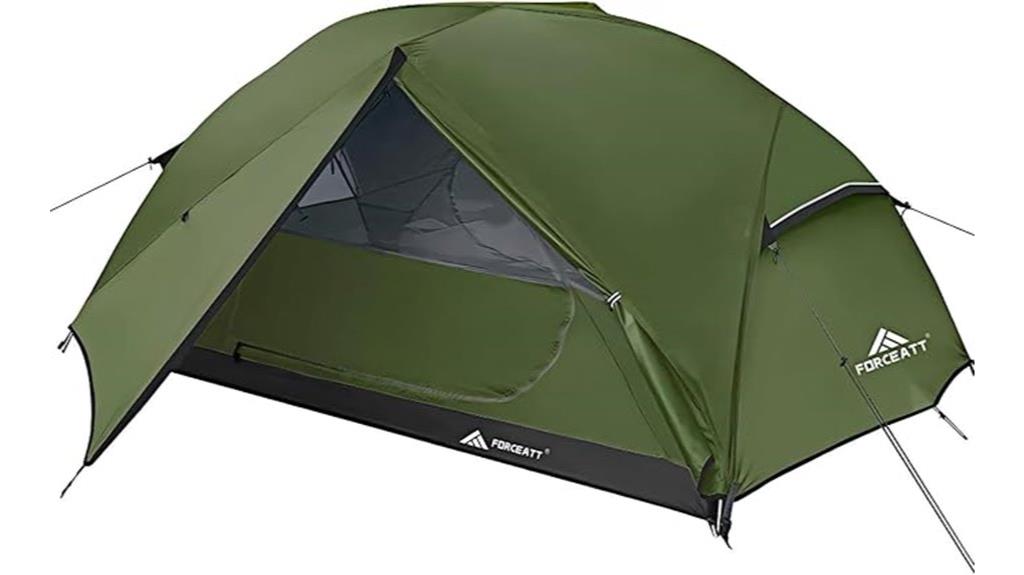
The Forceatt 2-3 Person Waterproof and Windproof Camping Tent stands out as an excellent choice for backpackers seeking a lightweight, easy-to-setup shelter that can handle a variety of weather conditions. Weighing just 5.1 pounds and featuring quick, intuitive assembly, it’s perfect for 3-4 season use. Its waterproof rating of 5000mm, welded floors, and full rainfly ensure dryness, while the wind-resistant design with reflective guylines offers stability in storms. The spacious interior includes dual doors, mesh windows, and ventilation, making it comfortable for one or two people. With durable aluminum poles and thoughtful organization features, it balances affordability, durability, and portability for outdoor adventures.
Best For: budget-conscious backpackers, beginner campers, and motorcycle travelers seeking a durable, easy-to-setup tent for 3-4 season use.
Pros:
- Lightweight and compact, weighing only 5.1 lbs, ideal for backpacking and motorcycle trips.
- Quick setup with intuitive pole design, taking approximately 3 minutes to assemble.
- Waterproof with a rating of 5000mm, welded floors, and full rainfly for reliable weather protection.
Cons:
- Small vestibules may limit gear storage and accessibility.
- Some seam sealing and workmanship imperfections noted, requiring additional waterproofing.
- Limited insulation for cold-weather camping, making it less suitable for winter conditions.
1 Person Backpacking Tent
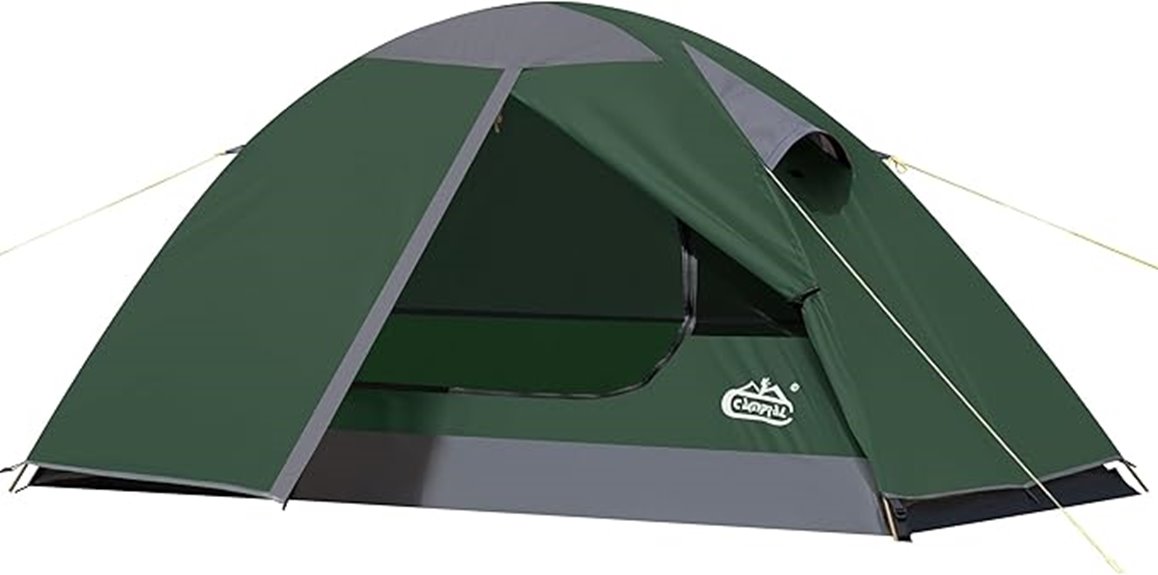
A person backpacking tent offers an unbeatable combination of lightweight design and compact size, making it ideal for solo adventurers who prioritize mobility. It weighs just 4.63 pounds and packs into a bag measuring 17.7 x 5.9 inches, perfect for carrying on long hikes. The tent’s dimensions—about 6.88 feet long, nearly 3 feet wide, and 3.6 feet high—provide comfortable space without bulk. Made from waterproof, tear-resistant materials, it’s built to withstand harsh weather. Quick to set up with freestanding aluminum poles, it’s stable in wind and rain, ensuring safety and comfort in any outdoor environment.
Best For: solo backpackers and hikers seeking a lightweight, compact, and weather-resistant tent for outdoor adventures.
Pros:
- Extremely lightweight at only 4.63 lbs, easy to carry on long hikes
- Quick and tool-free setup with freestanding aluminum poles
- Waterproof and durable materials ensure protection in harsh weather conditions
Cons:
- Limited space may not accommodate larger gear or additional occupants
- Less suitable for extreme winter conditions without additional insulation
- Mesh ventilation, while effective, may let in bugs if not properly sealed
ATEPA Ultralight Backpacking Tent for 1-2 Persons
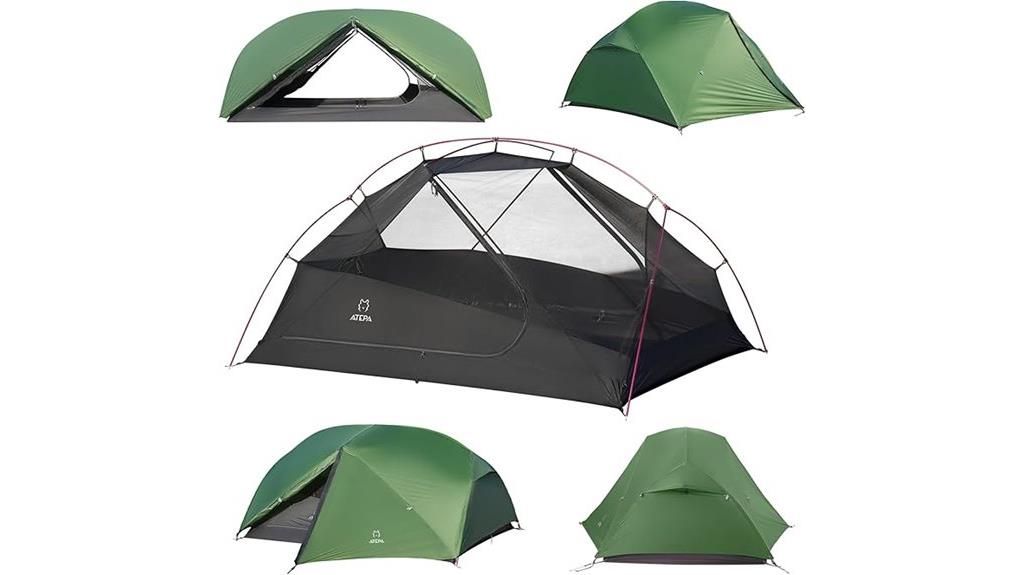
Designed for backpackers who prioritize lightweight and reliable shelter, the ATEPA Ultralight Backpacking Tent for 1-2 persons strikes a perfect balance between comfort and portability. It comfortably fits two, with an spacious interior and excellent ventilation thanks to dual vents and large mesh windows. Made from durable 20D silicone-coated nylon with taped seams, it’s waterproof up to 4,000MM+ and windproof, ensuring protection in harsh weather. Weighing around 3.7 pounds, it’s easy to carry and quick to set up with aluminum poles and clip attachments. Perfect for four-season adventures, it offers smart storage options, sturdy construction, and reliable performance for serious backpackers.
Best For: outdoor enthusiasts seeking a lightweight, durable, and spacious tent for backpacking, hiking, or four-season camping adventures.
Pros:
- Spacious interior with excellent ventilation and large mesh windows for airflow
- Lightweight design at around 3.7 pounds, ideal for backpacking and motorcycle camping
- Robust waterproofing (4,000MM+) and sturdy aluminum frame for reliable weather protection
Cons:
- Size may be less compact when packed, impacting ease of carry and storage
- Additional waterproof treatments and footprints recommended for prolonged backcountry use
- Slightly higher price point compared to basic tents, reflecting quality and features
GEERTOP Ultralight Bivy Tent for 1 Person
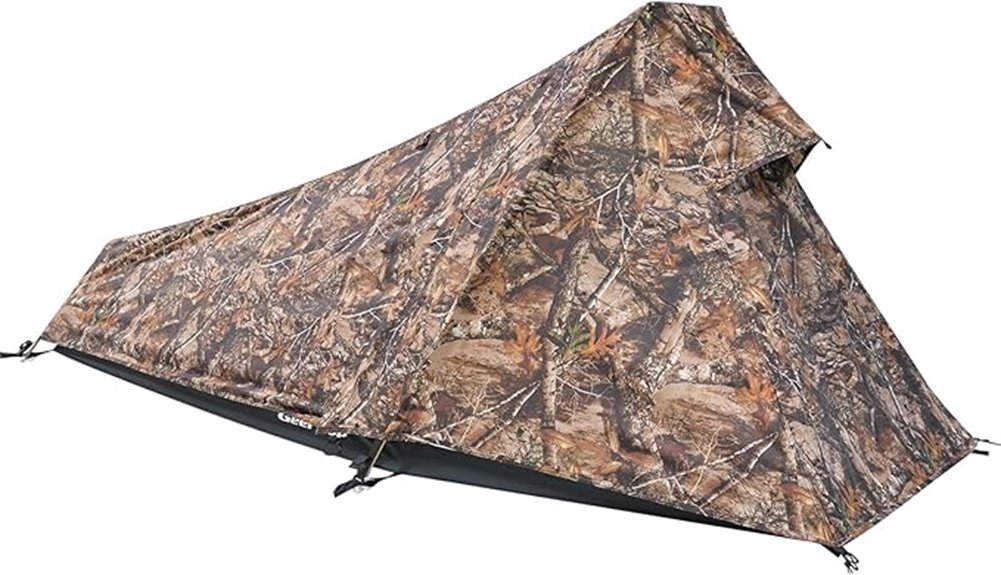
If you’re a solo backpacker seeking a lightweight shelter that doesn’t compromise on protection, the GEERTOP Ultralight Bivy Tent is an excellent choice. Weighing around 3.7 pounds, it features durable 210T ripstop polyester fabric and aluminum poles, making it both strong and lightweight. Its double-layer design with a waterproof flysheet rated at PU2500mm offers reliable protection from rain, wind, and UV rays across three seasons. The tent’s rectangular shape includes two doors, vestibules, and good ventilation, ensuring comfort and storage. Easy to set up in less than ten minutes, it’s ideal for stealth camping, hiking, and outdoor adventures where weight and concealment matter.
Best For: solo backpackers and outdoor enthusiasts seeking a lightweight, durable, and stealthy shelter for three-season camping and hiking trips.
Pros:
- Lightweight at approximately 3.7 pounds, making it easy to carry on extended hikes and backpacking trips
- Durable 210T ripstop polyester fabric combined with aluminum poles for strength and reliability
- Quick setup in less than ten minutes with a two-pole, tool-free frame system
Cons:
- Limited interior space may feel cramped for taller users or those needing extra room for gear
- Some reports of water ingress during heavy snow or prolonged rain, especially without added guidelines
- The fabric and stakes may bend or wear over time with frequent packing or in tough terrain
1 Person Camping Tent for Hiking, Mountain and Backpacking—Windproof, Rainproof, Waterproof, 4-Season
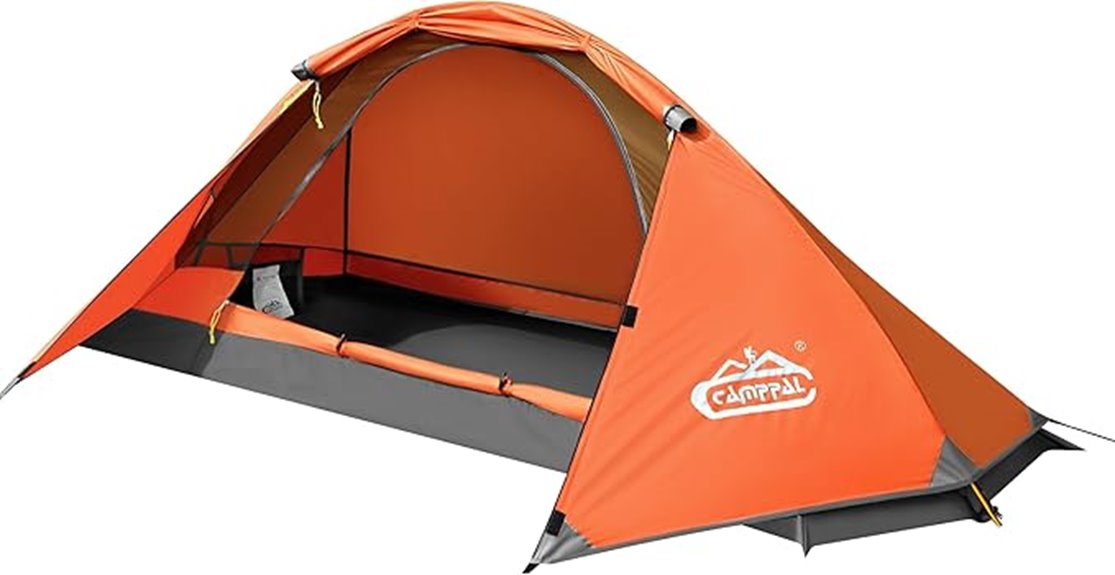
For solo hikers and backpackers seeking reliable shelter in all weather conditions, this 4-season tent offers exceptional windproof, rainproof, and waterproof performance. Weighing just 3.75 pounds, it’s easy to carry and quick to set up with a single ridge pole. Its anti-tearing rip-stop fabric and durable aluminum poles ensure stability against strong winds and storms. The waterproof fabric, rated up to 4000mm, keeps you dry even in heavy rain. With taped seams and water-resistant zippers, the interior stays dry and comfortable. Designed for versatility, it’s perfect for mountain adventures, hiking, and backpacking, providing peace of mind in harsh environments.
Best For: solo hikers, backpackers, and outdoor enthusiasts seeking a lightweight, durable, and weather-resistant tent for all-season adventures.
Pros:
- Lightweight at only 3.75 lbs, easy to carry and quick to set up with a single ridge pole.
- Excellent weather resistance with waterproof fabric rated up to 4000mm and taped seams to keep interior dry.
- Durable construction with anti-tearing rip-stop fabric and strong aluminum poles for stability in windy and stormy conditions.
Cons:
- Designed for one person, offering limited space for additional gear or comfort.
- May require practice for beginners to master the quick setup process.
- Limited ventilation features may affect airflow in very humid conditions.
Naturehike Cloud-Up 2 Person Tent
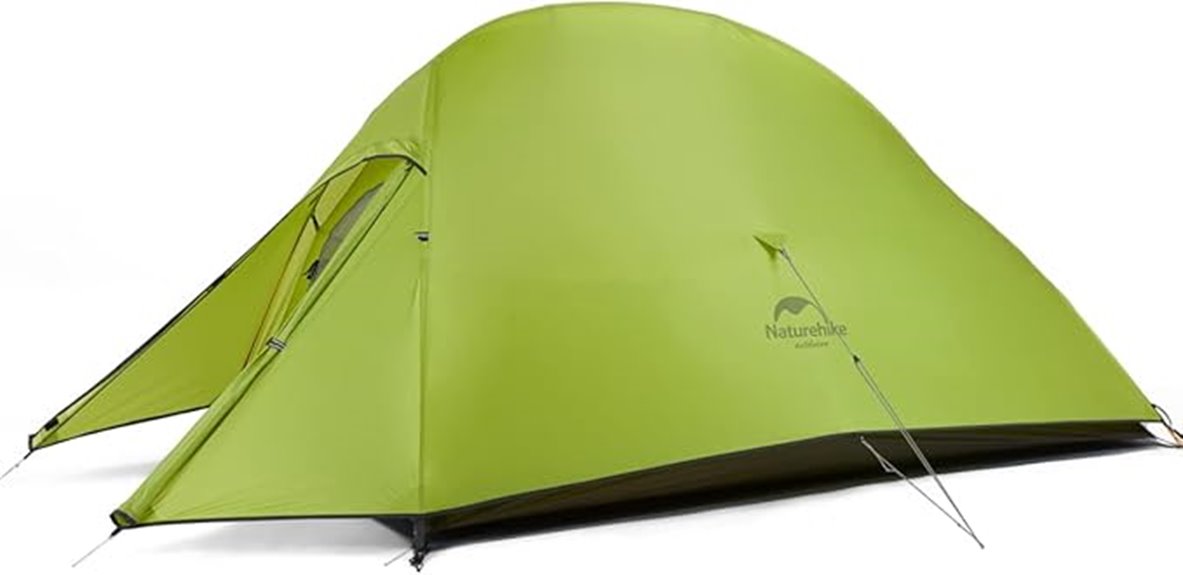
The Naturehike Cloud-Up 2 Person Tent stands out as an excellent choice for backpackers who prioritize lightweight gear without sacrificing durability. Weighing just 3.97 lbs, it’s incredibly portable and packs down to a compact size of 17.7” x 4.7”. Made from durable 20D nylon with a silicone coating, it’s waterproof and windproof, ready for all weather conditions. Setup is quick and straightforward, taking less than two minutes thanks to its self-standing aluminum poles. Its double-layer design enhances ventilation, while the included footprint and rainfly add extra protection. Overall, it’s a reliable, versatile tent perfect for backpacking, hiking, and outdoor adventures.
Best For: backpackers and outdoor enthusiasts seeking a lightweight, durable, and easy-to-setup tent for various weather conditions.
Pros:
- Ultralight design weighing only 3.97 lbs, ideal for backpacking and hiking.
- Quick setup in under two minutes with self-standing aluminum poles.
- Waterproof and windproof with sealed seams and durable nylon fabric, suitable for heavy rain and storms.
Cons:
- Limited interior space may be tight for two full-sized adults, especially for sitting upright.
- Single door design can be inconvenient during rain or windy conditions.
- Slightly heavier than some premium solo tents, which may be a consideration for solo backpackers.
3F UL GEAR Lanshan 2 Two Person Tent
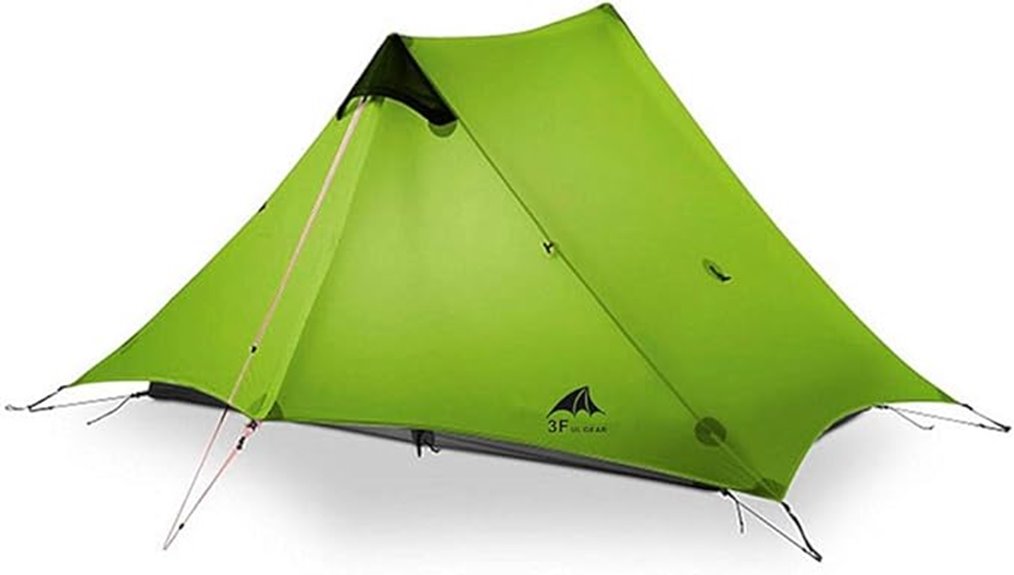
Designed specifically for backpackers who prioritize weight savings without sacrificing protection, the 3F UL GEAR Lanshan 2 Two Person Tent offers a highly portable shelter that can be set up in just minutes. Weighing around 1.15 kg (43 oz), it’s made from durable, waterproof 15D nylon with a waterproof rating of 5000+ mm, ensuring you stay dry in harsh weather. Its free-standing, rectangular design features two doors, two windows, and a vestibule for ventilation and storage. Using trekking poles as support, setup is quick and straightforward, making it ideal for three-season backpacking, rain, wind, or snow conditions without adding unnecessary weight.
Best For: backpackers and outdoor enthusiasts seeking a lightweight, durable, and quick-to-setup tent for three-season camping in varied weather conditions.
Pros:
- Extremely lightweight at approximately 1.15 kg (43 oz), ideal for backpacking
- Waterproof fabric with a rating of 5000+ mm ensures reliable protection against rain and snow
- Easy and quick setup using trekking poles, taking about 5 minutes
Cons:
- Lacks internal structure support, which may make it less stable in very windy conditions
- Thin fabric may be less durable in rugged terrain or heavy use over time
- Setup requires trekking poles (not included), so additional gear is needed for assembly
Big Agnes Copper Spur HV UL – Ultralight Backpacking Tent
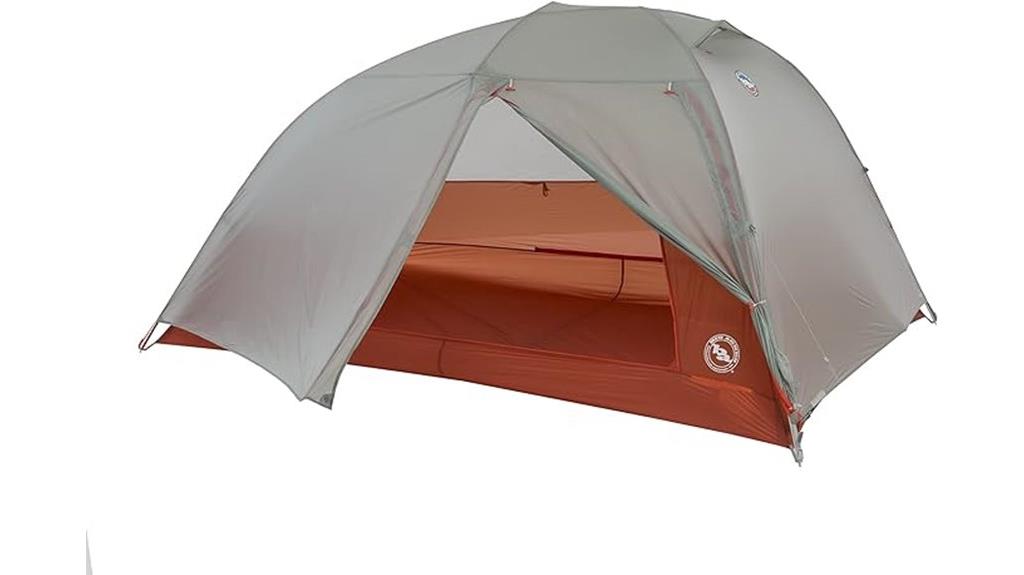
If you’re seeking a lightweight, full-featured backpacking tent that doesn’t compromise on stability or durability, the Big Agnes Copper Spur HV UL is an excellent choice. Designed for three, it’s made from tear-resistant nylon with mixed denier fabric for extra puncture resistance. It features two doors, two vestibules, interior pockets, and media routing. Setup is quick thanks to TipLok Tent Buckles and DAC poles, and its sturdy construction withstands high winds and storms. Weighing just under 3 pounds, it packs down small and offers plenty of space for gear and pets. It’s a reliable, easy-to-transport tent perfect for serious backpackers.
Best For: Backpackers and outdoor enthusiasts seeking a lightweight, durable, and easy-to-setup tent for multi-day adventures in various weather conditions.
Pros:
- Ultra-lightweight design (just under 3 lbs) ideal for solo and small-group backpacking.
- Quick and straightforward setup with TipLok Tent Buckles and DAC poles, saving time in the field.
- Robust construction with tear-resistant fabric and storm-tested stability in high winds and severe weather.
Cons:
- Requires separate purchase of the footprint for extended durability.
- Limited headroom for taller users, which may impact comfort during extended stays.
- Slightly compacted packed size may be tight for extra gear or accessories.
KAZOO Waterproof Backpacking Tent for 1-2 People
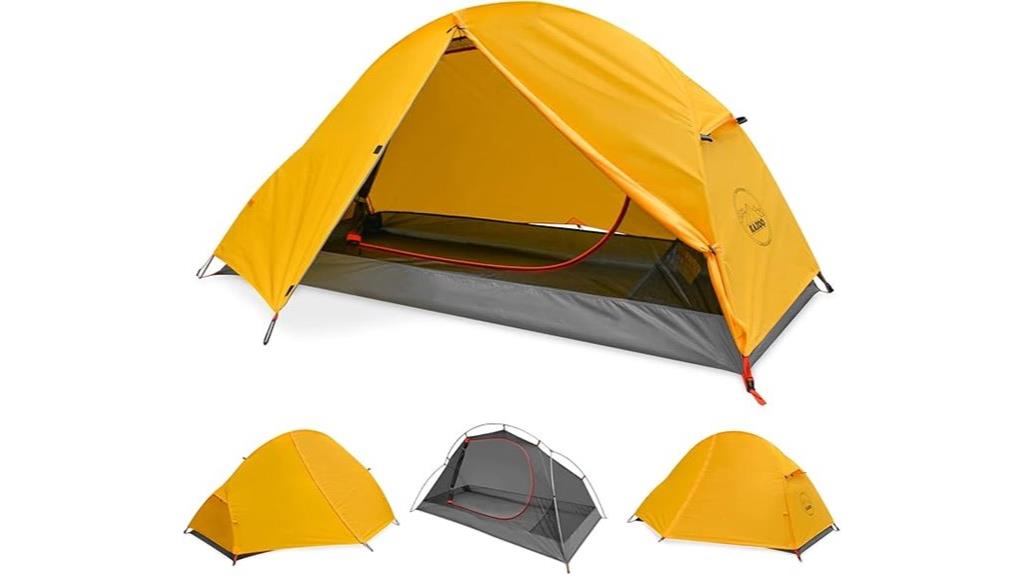
For solo backpackers or those traveling with a partner, the KAZOO Waterproof Backpacking Tent offers an exceptional balance of lightweight design and durability. Weighing just 3.3 pounds, it’s easy to carry and quick to set up with its freestanding frame and integrated aluminum poles. Made from recycled polyester and ripstop fabrics, it’s eco-friendly and highly durable. The tent provides reliable waterproof protection with a 3000 mm rating, breathable mesh, and taped seams. Ideal for three-season use, it includes a rainfly, stakes, and a repair kit. Its compact size makes it perfect for minimalist backpackers who want a dependable, eco-conscious shelter on the trail.
Best For: solo backpackers, minimalist campers, and outdoor enthusiasts seeking a lightweight, eco-friendly, and reliable shelter for three-season use.
Pros:
- Extremely lightweight at only 3.3 lbs, making it easy to carry on extended hikes.
- Quick and easy to set up with a freestanding design and integrated aluminum poles.
- Eco-friendly construction using recycled polyester and ripstop fabrics, offering durability and sustainability.
Cons:
- Slightly limited internal space, which may be tight for taller individuals or those with gear.
- Small vestibule area may restrict storage options and ease of access.
- The absence of a footprint could require additional ground protection or groundsheet for some users.
MC TOMOUNT Bivy Tent, Ultralight 2.42 lbs for Camping and Hiking
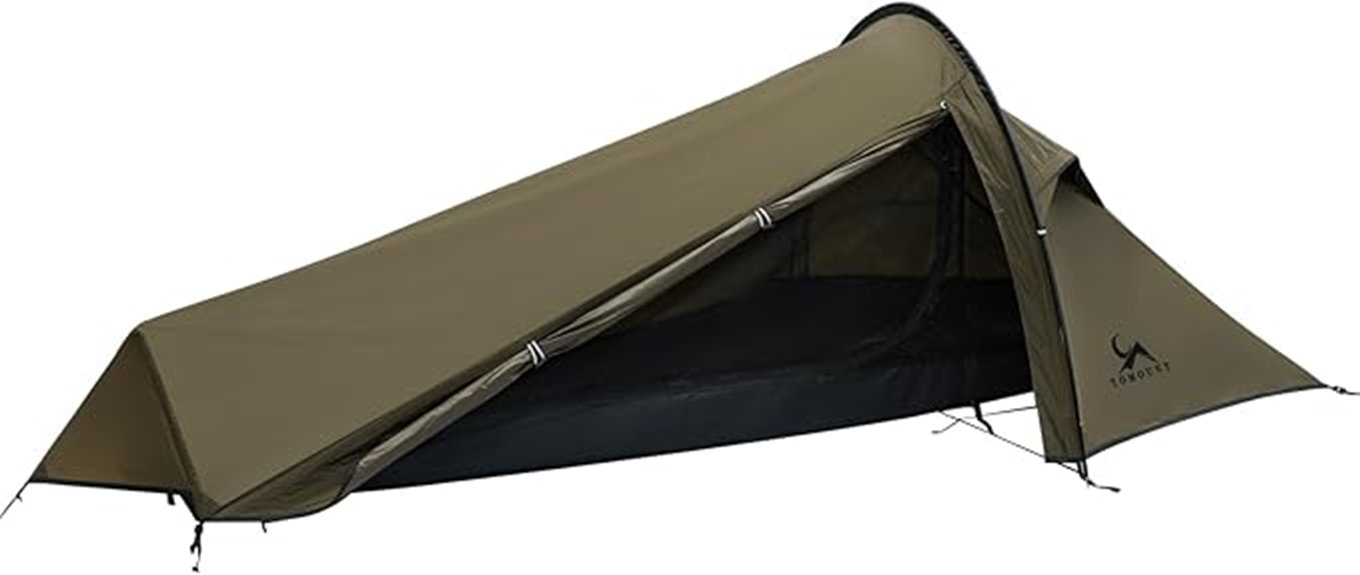
The MC TOMOUNT Bivy Tent stands out as an ideal choice for ultralight backpackers who prioritize minimal weight without sacrificing essential shelter features. Weighing just 2.42 pounds, it’s perfect for hiking and camping. Made from durable, waterproof 20D nylon with silicone coating, it offers reliable protection in various weather conditions. Its simple bivy design includes a single door, three mesh windows for ventilation, and a quick 3-minute setup with one aluminum pole. Compact when packed—measuring just 15.4×5.5 inches—it’s great for space-saving needs. While its minimalist interior and ventilation may limit comfort, it’s a solid, lightweight shelter for experienced campers seeking efficiency and durability.
Best For: ultralight backpackers and experienced campers seeking a minimalistic, durable shelter for varied weather conditions.
Pros:
- Extremely lightweight at only 2.42 lbs, ideal for reducing pack weight
- Quick and straightforward setup in approximately 3 minutes with minimal effort
- Waterproof and sunproof due to silicone-coated 20D nylon fabric and durable materials
Cons:
- Limited interior space and ventilation, which may cause discomfort in hot or rainy weather
- Potential quality control issues with poles, including bent or incorrect segments
- Cramped interior and complex setup straps may be challenging for some users to assemble or move comfortably
Factors to Consider When Choosing Ultralight Tents
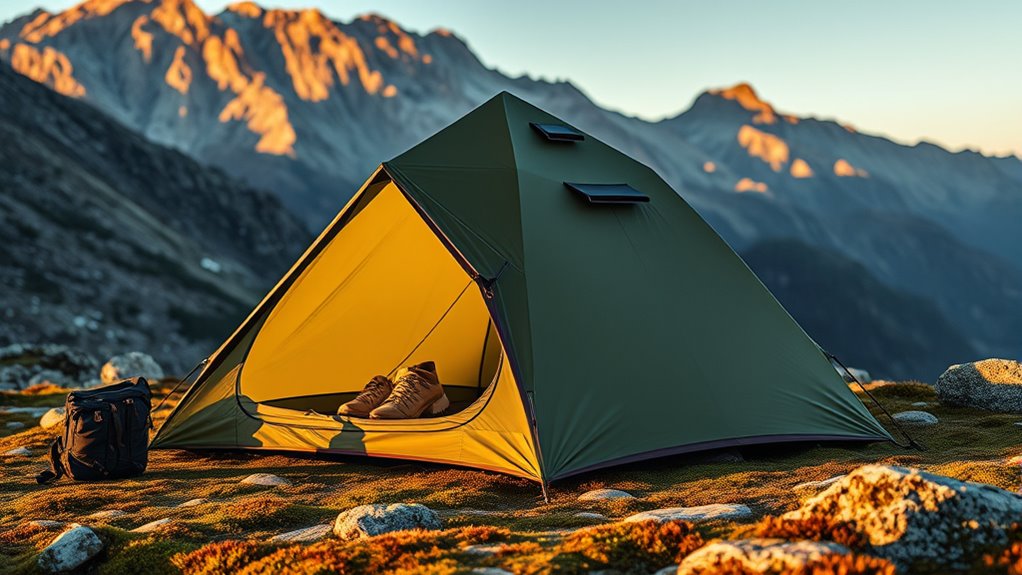
When choosing an ultralight tent, I focus on weight and portability to keep my pack manageable. I also consider weather resistance, so I stay dry in unexpected storms, and I look for easy setup to save time after a long day. Finally, I check the size, materials, and durability to make sure it’ll hold up on multiple trips without adding unnecessary weight.
Weight and Portability
Choosing an ultralight tent hinges on its weight and how easily I can carry it. These tents usually weigh under 4 pounds, which markedly helps reduce my backpack load. Their compact folded size, around 15-20 inches, makes packing effortless, fitting easily into small backpacks or gear bags. Lightweight materials like nylon, polyester, and aluminum keep the weight down without sacrificing durability. Quick setup and takedown are essential for portability, especially when I’m on a tight schedule or moving quickly. Carrying cases or stuffsacks designed for ultralight tents also help preserve their portability, making transportation smoother. Overall, the lighter and more compact the tent, the easier it is to carry, allowing me to focus more on the trail and less on my gear.
Weather Resistance Features
Since weather conditions can change rapidly on the trail, I prioritize ultralight tents with strong weather resistance features. A high waterproof rating, like PU 3000mm to 5000mm, ensures the tent can handle heavy rain without water seeping in. Sealed seams and taped construction are critical for preventing leaks at joins and zippers. Double-layer designs with rainflies and inner tents offer better protection, allowing ventilation while keeping moisture out. The bathtub-style floor with waterproof coatings and sealed edges keeps ground moisture from entering. Additional features like storm flaps, reinforced corners, and adjustable vents improve airflow and reduce condensation. These elements work together to make sure I stay dry and comfortable, regardless of unexpected weather shifts during my backpacking adventures.
Setup and Ease
Opting for an ultralight tent means prioritizing quick and straightforward setup, which is essential for saving time and energy on the trail. Most ultralight models can be pitched in just 3-5 minutes, thanks to simple designs and minimal poles. Many use freestanding structures with color-coded poles and quick-clip attachments, making assembly easy regardless of experience level. Some models might require trekking poles or support lines, adding a few steps but enhancing weight efficiency. Manufacturers often provide clear instructions and helpful videos to ensure hassle-free setup for beginners and seasoned backpackers alike. Overall, choosing a tent with intuitive features and minimal complexity allows you to focus more on your adventure and less on setup frustrations.
Size and Space
Have you ever wondered how much space you need in a tent to stay comfortable and organized? The size of ultralight tents varies from 1 to 4 pounds, with options for solo or group camping. Interior dimensions—length, width, and height—directly impact comfort and storage. A larger floor allows more sleeping pads or cots, while extra headroom makes moving around easier. Keep in mind, bigger tents offer more vestibule space and headroom but tend to be heavier and bulkier to pack. Finding the right balance between size and weight is key. Consider how much gear you’ll carry and how many people will sleep inside. Overall, choosing the right size guarantees you have enough space for your essentials without sacrificing portability on your backpacking adventures.
Durability and Materials
Choosing the right ultralight tent means paying close attention to the materials and construction, as these directly influence durability and weather resistance. Many ultralight tents use ripstop nylon or polyester with silicone or polyurethane coatings to balance weight and strength. Reinforced seams, double-stitching, and sealed seams are essential for preventing leaks and enhancing longevity. The materials, like aluminum poles and tear-resistant fabrics, are critical for withstanding wind, rain, and rough terrain. Waterproof ratings, such as 3000mm or 5000mm, indicate how well the fabric resists water penetration. Durability also depends on design features like reinforced stress points and robust joint construction, ensuring the tent can handle challenging conditions while remaining lightweight. Prioritizing quality materials and thoughtful construction is key to a reliable ultralight shelter.
Ventilation and Comfort
Good ventilation is essential when selecting an ultralight tent because it directly impacts comfort and condensation control. Adequate airflow is achieved through mesh panels, vents, and adjustable openings that prevent moisture buildup and keep the interior fresh. Proper ventilation helps maintain a comfortable temperature, especially in humid or warm conditions, by promoting air circulation. Tents with strategically placed vents near the top and sides allow moisture to escape efficiently, reducing condensation inside. Limited ventilation and cramped interiors increase humidity, leading to discomfort during long trips or in hot weather. Features like mesh doors, side vents, and removable rainflies boost airflow and support a more comfortable camping experience. Prioritizing ventilation ensures you stay dry, cool, and comfortable throughout your adventure.
Frequently Asked Questions
How Do Ultralight Tents Perform in Extreme Weather Conditions?
Extreme weather tests ultralight tents, and I’ve found they perform surprisingly well with proper design. High-quality materials and reinforced seams help withstand wind, rain, and snow. However, I always check the specs for water resistance and durability before heading out. While they’re lighter and easier to carry, I’m mindful that some ultra-light models may compromise slightly on protection. Proper setup and weather awareness are key to staying safe.
What Are the Best Materials for Durability in Ultralight Tents?
Imagine a hiker facing a sudden storm; the tent’s material needs to hold strong. I’ve found that ripstop nylon with a durable polyurethane or silicone coating is ideal for durability. These materials resist tears and water intrusion while remaining lightweight. In my experience, tents using these fabrics outperform others in rough conditions, offering a perfect balance of strength and weight—crucial for reliable backpacking adventures.
How Easy Is It to Set up Ultralight Tents Solo?
Setting up ultralight tents solo is surprisingly straightforward. I find most models come with simple, intuitive pole systems and clear instructions, making the process quick and stress-free. With some practice, I can pitch my tent in just a few minutes, even in challenging conditions. The key is choosing a design with minimal components and clear color-coded parts, which makes assembling solo much easier and more efficient.
Do Ultralight Tents Provide Adequate Ventilation?
Think of ultralight tents as the Swiss Army knives of camping gear. They often feature mesh panels and adjustable vents, making airflow a breeze. While some might worry about condensation, modern designs do a pretty good job of balancing ventilation with weather protection. So, yes, I find that most ultralight tents provide sufficient airflow, keeping me comfortable, even when camping in warmer or humid conditions.
What Is the Typical Lifespan of an Ultralight Backpacking Tent?
The typical lifespan of an ultralight backpacking tent varies, but I’ve found it usually lasts around 3 to 5 years with proper care. Factors like frequent use, exposure to harsh weather, and how well I maintain it can affect its durability. I make sure to clean and dry it after trips and store it properly, which helps extend its life and keeps it performing well on my adventures.
Conclusion
Choosing the right ultralight tent can truly enhance your backpacking adventures. With options ranging from compact bivies to spacious 2-person models, there’s something for everyone. Remember, durability and weight are key—so don’t compromise on quality for just a few grams. Ready to hit the trail with a tent that’s lightweight, reliable, and easy to carry? After all, isn’t the journey just as important as the destination?

